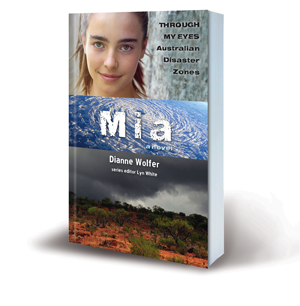>> About the books > Mia > Reviews
 What people are saying about Mia
What people are saying about Mia
'This series of books tells the stories of children across Australia and the world in a various array of disaster zones – natural and man-made. This is the story of one girl’s experience as a cyclone batters the area she lives in and affects everyone she knows, and her struggles with friends, school, and confidence, especially when a new girl shows up and it feels like Erin is pulling Kirra and Jess away from Mia. Mia’s story is filled with tension and fear which lead to lessons of bravery and the things you must do when it comes down to it. Most of us only ever hear about the impending cyclone and the following devastating destruction in the aftermath, and here, for readers aged eleven and older, because I think this book was a bit scary, is a story about how it feels to be in the storm.
Mia’s story puts us right in the line of the storm, and we hear the wind, feel the rain, see the flying debris, and the devastating aftermath. I felt everything Mia felt – her fear, her anxiety, her determination to make things work while her mum was away with minimal help, and minimal contact. As a reader, I felt that the present tense gave the story a sense of urgency, a sense of I must keep reading to see if Mia and the animals survive, and to see if she is reunited with her mother. Because there were times when I felt like my heart was in my throat, I think sensitive readers may struggle with this, or may need to talk this over with an older person. So it could be interesting to read this together, either out loud or as a buddy read in case you or a younger reader wants to talk about it.
I think it is also a good book for a class read – it can open all kinds of discussions, and illustrates that we all have different experiences, we all live in different areas, and can help children understand the many different ways we all live. At the back of the book, Dianne Wolfer acknowledges the Indigenous nations the book takes part on and acknowledges that she has focused on a singular experience. I think this was the best way to tell the story, because it was the immediacy of Mia’s experience that drew me into the story, even though it was anxiety inducing. The beginning is the calm before the storm, and I felt set the scene well – because as a reader, I could sense what was coming, I knew that something awful would happen yet it felt like the characters didn’t really know, or at the very least, didn’t expect it to be as bad as it was. I found this one compelling and wanted to read it all the time, but at the same time, when things got anxious, I had to take a break – and I found this was a really good way to read it, as I managed to finish it and enjoyed it, despite the hammering heart. I think it was because a part of me knew Mia and her mum would be okay in the end.
This book is an intriguing glimpse into a disaster zone, albeit one girl’s experience that encapsulates what it felt like, and allows readers a tiny glimpse into what it is like to be in a cyclone.'
Ashleigh Meikle, The Book Muse
'Thirteen year old Mia lives with her mother on an isolated bush block in the Pilbara. She dreams of becoming a vet like her mum and assists her whenever possible. They share their home with a menagerie of pets and recovering animals, and the three horses they use in their equine therapy sessions.
Her parents divorced a number of years ago, and her dad now lives in Perth with his new wife and their twins. Mia spends holidays with them and often Face-times. Her parents have an amicable relationship, and it’s refreshing to see a civilised divorce portrayed rather than the usual toxic and damaging divorces so often seen in books. Mia ‘feels grateful that her parents still get on okay’.
Seasonal cyclones are not unusual in the Pilbara, so when Mia’s mother is called out to help a mare with a complicated labour, they think she’ll only be gone a day at the most. However, Cyclone Veronica has other ideas! Mia finds herself alone as the cyclone intensifies and bears down on their property.
We learn that Mia suffers from anxiety, specifically climate anxiety, and has been seeing a counsellor who has taught her ‘ways to manage symptoms before they take hold’. She calls on these skills as she faces not only a cyclone, but a badly injured horse and rising flood-water, alone!
Mia may be facing a natural disaster, but she is also dealing with the usual concerns of a thirteen year old: do her friends still like her or are they falling under the spell of the new, fashionable girl at school? Will she be able to give her presentation to her English class without having an anxiety attack?
Readers will find Mia a relatable character, who is not fearless, but rather draws on her inner strength to overcome her fears so she can stay safe and save her beloved animals.
The book contains a detailed timeline of Cyclone Veronica’s impact on Australia, together with a list of resources if readers would like to explore more about the many issues raised by the story.'
Gaby Meares, Reading Time